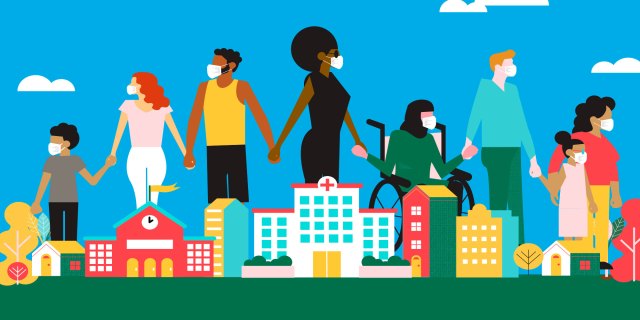This piece was published in Fast Company on March 6, 2019.
Over the past several years, many of us have come to rely on technology to make more informed decisions about our lives. Some of them help us day to day–like which roads we should take on the way home, or what foods we should eat, or how we should manage our workouts. Others are more consequential. In hospitals, doctors are using technology to follow how their patients fare, not just over days and weeks, but years. In agriculture, farmers are choosing what and when they plant by analyzing decades of crop data.
The larger trend is clear: In more and more parts of American life, people are using technology to understand historical patterns and make smarter decisions about the future. So why is just a fraction of this energy being directed at some of our most pressing, complicated human problems? At the Chan Zuckerberg Initiative, we’re helping build collaboration between technologists and practitioners on the front lines in communities leading the efforts to solve real-world challenges.
In our criminal justice system, for example–where even a routine, everyday decision can permanently alter the course of someone’s life–we know that data-informed decision-making is rare. We also know that the impact of this system is massive. Today one out of every two Americans has an immediate family member who’s been incarcerated, with a disproportionate impact on the poor and communities of color. I’m interested in how technology can better serve these groups that are getting left behind.
A DAY IN THE LIFE
If you want to see what the status quo in criminal justice looks like, just try stepping into the shoes of a junior prosecutor. When she walks into the office on a typical morning, she’s likely to have a stack of police reports waiting on her desk–and a duty to make charging decisions quickly out of respect for the Constitutional rights of the defendant. For each case, she’ll have to make a series of rapid choices. What charges should we bring against this person? Was the crime a felony, a misdemeanor, or nothing at all? Should the defendant be held on bail? Should they be kept in custody?
While the prosecutor has a short window of time to make decisions–sometimes just a few moments before court begins–the consequences for the accused can last a lifetime. And, unfortunately, almost no one looks closely at what happens to each defendant as they move through the system, so the prosecutor won’t have the opportunity to learn whether certain choices are actually rehabilitating, or making communities safer. If she wants to know whether a particular charge, conviction, or diversion is likely to keep an offender from committing another crime, or make it harder for them to one day find a job or a place to live, she’s out of luck. That data isn’t really available.
This has a lot to do with the way the system defines wins and losses. When the primary indicator of success is conviction rate, activities like long-term outcome mapping are tough to prioritize. The thing is, those insights are exactly what’s needed to catalyze a new incentive structure. What would it look like if, instead of counting convictions, we measured success by what happens after someone encounters the justice system? What does a person’s life look like 5, 10, or 20 years after their arrest? Do they have stable work and housing? Did they remain crime free? This more holistic, long-term approach would also allow us to better understand what types of interventions–from education and training programs within prisons, to state and federal policies–should be invested in at scale to help produce those outcomes.
FUELING THE CYCLE
On the other side of dataless decision-making are the problematic technology tools that do exist in some court systems. In certain cases, “risk-assessment” tools use basic data about a person–like age, gender, and past criminal records–to predict who is most likely to commit future crimes. Though likely well-intentioned, tools made to expedite existing processes and uphold existing structures may end up amplifying, rather than interrogating, the deep biases that plague our criminal justice system. African Americans and Latinos account for a third of the total U.S. population, but make up more than half of our prison population. This truth has to factor into all decisions we make about the best paths forward.
The question now is not how technology can fix these issues (it’s far from a silver bullet), but rather how it can be appropriately harnessed to help key actors in the justice system make evidence-based decisions, and move toward something that’s fairer, more equitable, more transparent, and actually safety-oriented. To get there, it’s critical that tools are developed through the frame of equity over efficiency, and of redemption and safety over punishment.
One valuable thing technology can do is collect and organize accurate, contextualized information. Today, decision-makers–from prosecutors to judges to parole officers–don’t always have a lot of background on the defendants who enter the system. This could be something as nuanced as whether the accused is involved in another case as a victim of crime, or as broad as what conditions and circumstances caused them to enter the system.
In addition to better decision-making processes, there are many use cases where the right technology can add tremendous value. Like when friends and family have valuable context to share with the courts, but no clear way to provide it. Or chief prosecutors who want to make changes but may not know how their sentencing practices compare to their peers’. Thoughtful tools can also play a role in helping people move past their convictions and rebuild their lives after incarceration. Specifically, people who have paid their debt to society and want a fresh start, but struggle to access basic needs like housing and jobs due to their criminal records.
Fortunately, some organizations are beginning to work toward solutions like these. One of them, called Measures for Justice, recently launched an online portal with criminal case data from 300 counties in six states. Another organization, Silicon Valley De-Bug, has pioneered a practice called participatory defense that is helping friends and family members of the accused share vital information with judges, prosecutors, and public defenders. Early results suggest that it could make a big difference. On record clearing, new Clean Slate coalitions are emerging to help drive policy solutions that would automatically clear certain records over time.
As more resources like this are developed, actors in the system will have an unprecedented opportunity to learn which choices are likely to create positive pathways for individuals and communities alike. That way, more decisions can be informed by a thorough consideration of the long-term outcomes.
COLLABORATION IS KEY
Of course, the work of reforming our criminal justice system began long before Silicon Valley came along–and for any new technology to be useful, it must draw on the wisdom of people who have been doing this work for decades, and support their efforts. That means engaging local community organizers who are working to hold local courts and prisons accountable in their communities. It means working directly with those impacted by the justice system, including families and victims of crime, to ensure that technology serves their needs and protects their privacy. It means collaborating with state and local legislatures. And it means engaging prosecutors themselves, who are increasingly elected on the basis of delivering reform. Importantly, it also means that the teams building the tools must represent the diverse world we live in. Having a wide range of voices at the table can mean the difference between a solution that erases bias and one that inadvertently reinforces it.
Reversing mass incarceration is no easy task–nor is shifting the conditions that created it. But the movement to do so is growing larger and stronger every day. Ensuring that reformers have the resources and the right technology they need to achieve their goals can help create a justice system that lives up to its name.
###
David Plouffe is the head of policy and advocacy at the Chan Zuckerberg Initiative and former campaign manager and senior adviser to President Barack Obama.





